Tartu Semiotics Library
Overview
Tartu Semiotics Library is an international book series on semiotics that includes monographs, handbooks, dictionaries, textbooks and collections of articles in the field of semiotics. The series was established in 1998, by Peeter Torop, Mihhail Lotman, and Kalevi Kull.
1-2 volumes are published each year. The main language of publication is English, but some volumes have been published in Russian and in Estonian.
Editorial information
Series Editors: Kalevi Kull, Peeter Torop, Silvi Salupere
Contact Address: Department of Semiotics, University of Tartu, Jakobi 2, Tartu 51014, Estonia
Editorial Board: Tatiana Chernigovskaja (St Petersburg, Russia); Robert Innis (University of Massachusetts Lowell, USA); Frederik Stjernfelt (Aarhus University, Denmark); Jaan Valsiner (Clark University, USA); Ekaterina Velmezova (Lausanne University, Switzerland); Vilmos Voigt (Eötvös Loránd University, Hungary)
Series Home Page: http://www.flfi.ut.ee/en/department-semiotics/tartu-semiotics-library
ISSN 1406-4278
Volumes published
Vol. 1. V. V. Ivanov, J. M. Lotman, A. M. Pjatigorski, V. N. Toporov, B. A. Uspenskij. Theses on the Semiotic Study of Cultures = Kultuurisemiootika teesid = Тезисы к семиотическому изучению культур, 1998. 88 p. ISBN 998540064X.
Vol. 2. Jan Levchenko, Silvi Salupere (ed.). Conceptual Dictionary of the Tartu-Moscow Semiotic School, 1999. 408 p. ISBN 9985564456.
Vol. 3. Claus Emmeche, Kalevi Kull, Frederik Stjernfelt. Reading Hoffmeyer, Rethinking Biology, 2002. 79 p. ISBN 9985566327.
Vol. 4. John Deely. Basics of Semiotics = Semiootika alused. 4th ed., 2005. 567 p. ISBN 9949110866.
5th ed. published separately in English and Estonian in 2009.
Vol. 6. Peet Lepik. Universaalidest Juri Lotmani semiootika kontekstis, 2007. 246 p. ISBN 9789949117871.
Vol. 7. Peet Lepik. Universals in the Context of Juri Lotman's Semiotics, 2008. 269 p. ISBN 9789949118311.
Vol. 8. Charbel Niño El-Hani, João Queiroz, Claus Emmeche. Genes, Information, and Semiosis, 2009. 252 p. ISBN 9789949190386.
Indexing: Web of Science™ Core Collection
Vol. 9. Anti Randviir. Ruumisemiootika: tähendusliku maailma kaardistamine [Semiotics of space: mapping the meaningful world], 2010. 358 p. ISBN 9789949193981.
Vol. 10. Donald Favareau, Paul Cobley, Kalevi Kull (eds.). A More Developed Sign: Interpreting the Work of Jesper Hoffmeyer, 2012. 335 p. ISBN 9789949199457.
Available in OAPEN
Available in DOAB
Indexing: Web of Science™ Core Collection
Vol. 11. Silver Rattasepp, Tyler Bennett (eds.). Gatherings in Biosemiotics, 2012. 242 p. ISBN 9789949320486.
Indexing: Web of Science™ Core Collection
Vol. 12. Floyd Merrell. Meaning making: it's what we do; it's who we are, 2013. 321 p. ISBN 9789949323111.
Indexing: Web of Science™ Core Collection
Vol. 13. Silvi Salupere, Peeter Torop, Kalevi Kull (eds.). Beginnings of the semiotics of culture, 2013. 133 p. ISBN 9789949323234.
Vol. 14. Marcel Danesi, Mariana Bockarova. Mathematics as a modeling system: a semiotic approach, 2014. 158 p. ISBN 978-9949-32-610-5.
Indexing: Web of Science™ Core Collection
Vol. 15. Dinda L. Gorlée. From Translation to Transduction: The Glassy Essence of Intersemiosis, 2015. 260 p. ISBN 977-1406-42-701-2.
Indexing: Web of Science™ Core Collection
Vol. 16. Claudio Julio Rodríguez Higuera, Tyler James Bennett (eds.). Concepts for Semiotics, 2016. 256 p. ISBN 978-9949-77-258-2.
Indexing: Web of Science™ Core Collection
Vol. 17. Douglas Robinson. Semiotranslating Peirce, 2016. 280 p. ISBN 978-9949-77-247-6.
Indexing: Web of Science™ Core Collection
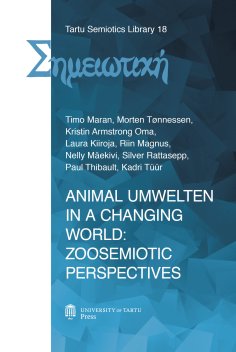
Vol. 18. Timo Maran, Morten Tønnessen, Kristin Armstrong Oma, Laura Kiiroja, Riin Magnus, Nelly Mäekivi, Silver Rattasepp, Paul Thibault, Kadri Tüür. Animal Umwelten in a Changing world: Zoosemiotic Perspectives, 2016. 276 p. ISBN 978-9949-77-280-3.
Available in OAPEN
Available in DOAB
The book raises semiotic questions of human–animal relations: what is the semiotic character of different species, how humans endow animals with meaning, and how animal sign exchange and communication has coped with environmental change. The book takes a zoosemiotic approach and considers different species as being integrated with the environment via their specific umwelt or subjective perceptual world. The authors elaborate J. v. Uexküll’s concept of umwelt to make it applicable for analyzing complex and dynamical interactions between animals, humans, environment and culture. The opening chapters of the book present a framework for philosophical, historical, epistemological and methodological aspects of zoosemiotic research. These initial considerations are followed by specific case studies: on human–animal interactions in zoological gardens, communication in the teams of visually disabled persons and guiding dogs, semiotics of the animal condition in philosophy, historical changes in the role of animals in human households, the semiotics of predation, cultural perception of novel species, and other topics. The authors belong to the research group in zoosemiotics and human–animal relations based in the Department of Semiotics at the University of Tartu in Estonia, and in the University of Stavanger in Norway.
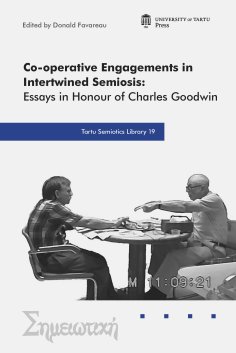
Vol. 19. Donald Favareau (ed.). Co-operative Engagements in Intertwined Semiosis: Essays in Honour of Charles Goodwin, 2018. 418 p. ISBN 978-9949-77-688-7.
For almost 40 years Charles Goodwin’s pioneering work has re-shaped the field of human interaction studies and has shed light on a pervasive form of social action that he calls intertwined semiosis.
Defined as the act of laminating different kinds of semiotic materials, contributed by different actors, into local arrangements for the building of conjoint action, intertwined semiosis, Goodwin maintains, is the distinctive form of human sociality and cognition.
Moreover, in the course of making his extremely detailed and astute investigations into what human sign users are doing as they make meaning with one another in real time, Goodwin’s extraordinary eye as a naturalist and mind of an anthropologist have allowed him to unearth for us the essence of the distributed, embodied and multi-modal practices of intertwined semiosis that are central to the human calibration of experience and knowledge in both every-day and institutional settings.
His dynamic view on linguistic, embodied, and material resources has been shown to hold not only for co-present interaction – i.e., within the situated hic et nunc of talk as it emerges moment-by-moment – but also for historically linked chains of actions across contexts, generations, historical moments and even species.
Goodwin’s work thus constitutes a fundamental contribution to the study of human ways of knowing, acting and being, and has inspired not only at least two generations of interaction scholars, but also linguists, cognitive scientists, semioticians, anthropologists, and philosophers.
Accordingly, one finds in this volume a wide-ranging assortment of reflections and analyses, each of which constitutes a deeply-felt testament and tribute to Charles Goodwin’s extraordinary ideas, career, personality and life, and together forming the most comprehensive single-volume assessment to date of his outstandingly original and profound oeuvre in the analysis of human meaning-making.
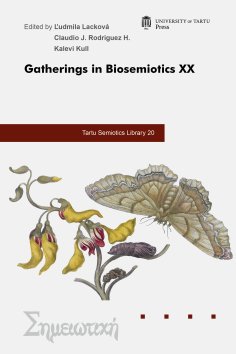
Vol. 20. Ľudmila Lacková, Claudio J. Rodríguez H., Kalevi Kull (eds.). Gatherings in Biosemiotics XX, 2020. 333 p. ISBN 978-9949-03-514-4.
Biosemiotics is the study of semiosis in the biological realm. Or, as it was written in the introduction to the 17th Gatherings in Biosemiotics in Lausanne, “biosemiotics is [...] the study of meaning-making and its consequences in living systems, and much of its focus is on investigating and understanding pre-linguistic sign processes in both humans and other organisms”.
Biology, on the one hand, has an important and impressive history of studying the systematicity of nature, as it is exhibited in the analyses of the genetic, physiological and morphogenetic processes of living systems. Yet biology, at the same time, must also certainly recognize that it is likewise the study of the systematicity of freedom, in as much as its object of study is the phenomenon of life itself. And so biology, understood as biosemiotics, studies life’s capacity for aboutness, for establishing mediated and arbitrary relationships that result in the creation of novelty, for making choices, and for the ongoing exploration of possibility.
The world meetings on biosemiotics – Gatherings in Biosemiotics – have been taking place annually since 2001. The first twelve years of these conferences was described in a volume of 2012, while the current volume covers the meetings from 2012 to 2020. In addition to the accounts and programs of these events, and including over sixty contributions to the twentieth meeting, the current volume includes review articles, evaluating the work done thus far, and predicting future developments. The history and philosophy of Czech biosemiotics, in particular, receives a detailed account, and many other new ideas in biosemiotics are also discussed in this book.
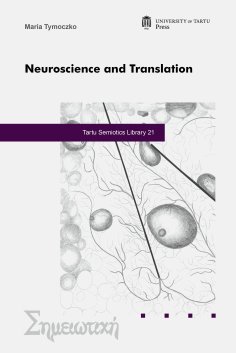
Vol. 21. Maria Tymoczko. Neuroscience and Translation, 2021. 408 p. ISBN 978-9949-03-554-0.
Many of the basics of the neuroscience of perception, memory, plasticity, attention, decisions, choices, and control have achieved consensus. Accordingly it is now possible to use this research to investigate the implications for cognition and behavior associated with language, multilingualism, and translation, as well as related phenomena such as semiosis and cross-cultural communication. (P. 12)
We are “born to choose”. Belief in one’s ability to exert control over the environment through choice is essential to well-being. People desire both choice and control. Translation is an activity that instrumentalizes these functions. (P. 357)
Maria Tymoczko is Professor of Comparative Literature at the University of Massachusetts Amherst. She holds three degrees from Harvard University, where she studied the topics discussed in her research and publications: the sciences, medieval languages and literatures, and topics related to translation theory and practice. Her books include The Irish “Ulysses” (University of California Press, 1994), Translation in a Postcolonial Context (St. Jerome Publishing, 1999), Enlarging Translation, Empowering Translators (St. Jerome Publishing, 2007), and several edited volumes on translation research.
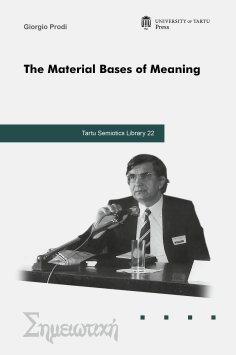
Vol. 22. Giorgio Prodi. The Material Bases of Meaning, 2021. 218 p. ISBN 978-9949-03-564-9.
Available in OAPEN
Contemporary semiotics has often gone too far in proposing language as the model to explain every phenomenon of communication. Giorgio Prodi’s seminal book, originally published in Italian in 1977, poses the question from the opposite perspective: his ‘natural history of meaning’ does not depict a biological universe that behaves as if it spoke, but a cultural universe structured even at its highest levels according to the same modes and processes of mutual adaptation and ‘reading’ that happen at the level of cells.
The picture he paints shows us knowledge at its origin, as a process of environmental adaptation and interpretation, in which the discoveries of biology interact with those of semiotics. Within this natural history of language competence, the book emphasises the remote, primitive phase, which takes place below the threshold of the subjective and the social. Proceeding from there it outlines a holistic hypothesis of semiosis at the cultural level: the elementary phases of the recognition of meaning, which become progressively more complex as the phylogenesis progresses, lead all the way to the construction of linguistic systems in the human animal.
This is an investigation of the elementary biological processes in order to identify the material logic that is the foundation of the higher processes of meaning-making – prehistory of the sign, biology of semiosis: from the side of nature and from the side of culture.
Giorgio Prodi (1928–1987) was an Italian oncologist and a pioneer of biosemiotics.
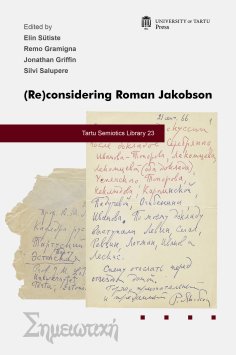
Vol. 23. Elin Sütiste, Remo Gramigna, Jonathan Griffin, Silvi Salupere (eds.). (Re)considering Roman Jakobson, 2021. 264 p. ISBN 978-9949-03-630-1.
This book was initiated by a graduate course on the semiotics of Roman Jakobson (1896–1982), taught by Elin Sütiste at the Department of Semiotics, University of Tartu. The contributions include articles by participants in the course as well as visiting scholars and colleagues at the University.
The seminars affirmed that Jakobson was truly an ambitious, forward-thinking scholar who exerted himself to establish semiotics as a discipline. Although Jakobson identified himself as a philologist, he played a pivotal role in the development and institutionalization of semiotics.
Jakobson’s ability to grasp the potential of new ideas and to inspire others was remarkable. Juri Lotman commented on this, “Wherever his fate of a mid-20th-century man took him, everywhere Jakobson attracted a group of scientists that soon grew into a scientific centre of global importance”.
The volume explores specific points of relevance to contemporary semiotics found in Jakobson’s work, while each of the 13 essays approaches the issues from a different angle.
The authors: Tyler James Bennett, Taras Boyko, Eugenio Israel Chavez Barreto, Remo Gramigna, Jonathan Griffin, Vít Gvoždiak, Katalin Kroó, Bruno Osimo, Ott Puumeister, Rasmus Rebane, Claudio Julio Rodríguez Higuera, Elin Sütiste, Linda R. Waugh.
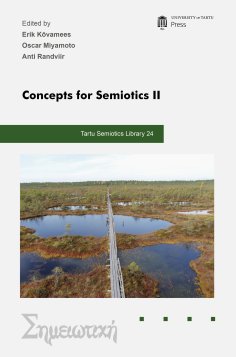
Vol. 24. Erik Kõvamees, Oscar Miyamoto, Anti Randviir (eds.). Concepts for Semiotics II, 2023. 256 p. ISBN 978-9916-27-244-2.
Highlighting concepts in the paradigm of semiotics is of growing importance in the era of contemporary transdisciplinary developments. Semiotic concepts are decisive for theoretical foundations in the inspection and explanation of culture, society, ecosystem, and humans themselves, as they also have high value for diverse applied studies that target objects loaded with meaning. Similar to its predecessor Concepts for Semiotics (2016), the present volume showcases the ongoing research of Tartu semiotics scholars advancing the state of the art in semiotics on diverse fronts. Attention is paid to both overall theoretical issues concerning semiotic terminology, and to specific concepts in their methodological value and spectrum.
This work was motivated by the need to reflect on the terminological “interface” or “metalanguage” with which we communicate as an epistemic community in dialogue with other disciplines. This is done, on the one hand, by deconstructing the limits of foundational concepts in the field (e.g., “theory”, “diagram”, “affordance”, “self”). And, on the other hand, by constructing improved definitions that more accurately reflect the processual reality of complex phenomena (e.g., “spectacle”, “enchantment”, “authentication”, “meaning-breaking”, “modal reality”, etc.).
Although every contribution specializes according to a particular conceptual framework, the anthology as a whole represents the complementarity of different approaches, such as cultural semiotics, biosemiotics, sociosemiotics, Greimassian semiotics, Peircean semiotics, critical theory, and Buddhist studies. As a result, the anthology takes a step back from current semiotic trends (usually based on topics or “themes”) and highlights the importance of semiotic terminology as a methodological bridge between theory and practice.
